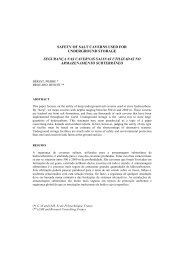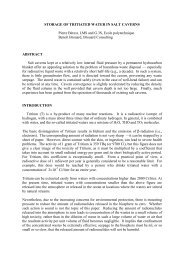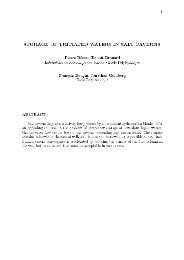Deep salt-cavern abandonment - Brouard Consulting
Deep salt-cavern abandonment - Brouard Consulting
Deep salt-cavern abandonment - Brouard Consulting
Create successful ePaper yourself
Turn your PDF publications into a flip-book with our unique Google optimized e-Paper software.
1 In the long term, rock <strong>salt</strong> flows even under very<br />
small deviatoric stresses.<br />
2 Creep rate is a highly non-linear function of applied<br />
deviatoric stress and temperature.<br />
3 Steady-state creep is reached after several weeks or<br />
months when a constant load is applied to a sample;<br />
it is characterized by a constant creep rate.<br />
4 Transient creep is triggered by any change in the<br />
state of stress; it is characterized by high initial<br />
rates (following a deviatoric stress increase) that<br />
slowly reduce to reach steady-state creep.<br />
5 When deviatoric stress is large (compared to the<br />
mean stress), <strong>salt</strong> may experience damage and<br />
dilatancy, and its permeability drastically increases.<br />
The same occurs when <strong>salt</strong> is in contact with brine<br />
which has pressure that is higher than the minimum<br />
principal stress (Fokker 1995).<br />
The main features of steady-state creep are captured<br />
by the following simple model (Norton-Hoff power<br />
law):<br />
ε = ε + ε<br />
(9)<br />
ij ij ij<br />
e ss<br />
( J2<br />
)<br />
1<br />
n 1<br />
ij −Q<br />
∂<br />
+<br />
<br />
⎛ ⎞<br />
ε<br />
ss<br />
= Aexp ⎡<br />
3<br />
⎤<br />
⎜ ⎟ (10)<br />
⎝RT<br />
⎠n<br />
+ 1 ∂σ<br />
⎢⎣<br />
⎥⎦<br />
ij<br />
ij<br />
E ε = (1 + νσ ) − νσ δ + α T<br />
δ<br />
(11)<br />
e ij kk ij <strong>salt</strong> ij<br />
where J 2 is the second invariant of the deviatoric stress<br />
tensor; E, ν, α <strong>salt</strong> , A, n, Q/R are model parameters.<br />
Several authors suggest constitutive laws that take<br />
into account transient creep. A complete set of<br />
equations can write:<br />
ε = ε + F ε<br />
(12)<br />
ij ij ij<br />
e ss<br />
σ =<br />
(13)<br />
ij, j<br />
0<br />
σ ( x =∞ , tn ) =− Pn<br />
(14)<br />
ij j ∞ j<br />
( wall, t) n ( )<br />
σ =− P t n<br />
(15)<br />
ij j j<br />
where F is a multiplying factor (introduced by<br />
Munson & Dawson (1986) to account for transient<br />
creep). The second relation is the equilibrium<br />
condition, and (14) and (15) are the boundary<br />
conditions. Numerical computation allows <strong>cavern</strong><br />
convergence (i.e. loss of volume) to be assessed as a<br />
function of time and <strong>cavern</strong> pressure history.<br />
Values of the parameters A, n, Q/R (as measured<br />
during laboratory experiments) were collected by<br />
<strong>Brouard</strong> & Bérest (1998): for 12 different <strong>salt</strong>s,<br />
constant n is in the range n = 3-6, illustrating the<br />
highly non-linear effect of applied stress on the strain<br />
rate, and Q/R ranges from 4000 to 10,000 K. It must<br />
be noted, however, that, especially in the case of<br />
bedded <strong>salt</strong> formations containing a fair amount of<br />
insolubles, laboratory test results often are scattered.<br />
2.7 Salt permeability<br />
For every standard engineering purpose, rock <strong>salt</strong> can<br />
be considered as an impermeable rock. Its matrix<br />
hydraulic conductivity is small, and no fractures exist<br />
in a massive <strong>salt</strong> formation. The generally low<br />
permeability numbers resulting from laboratory tests<br />
hyd −21 2<br />
-18 2<br />
are scattered ( K <strong>salt</strong><br />
= 10 m to 10 m .) Some<br />
authors believe that in situ (virgin) permeability is null<br />
(Lux et al. 2006). In situ tests were performed in<br />
bedded <strong>salt</strong> formations. A 1-year-long test performed<br />
in a well at Etrez site and supported by the SMRI<br />
hyd<br />
−20 2<br />
(Durup 1994) gave K <strong>salt</strong><br />
= 6× 10 m . Another<br />
SMRI-supported <strong>abandonment</strong> test at the same site,<br />
hyd<br />
−19 2<br />
(Bérest et al. 2001) gave K <strong>salt</strong><br />
= 2× 10 m . Such<br />
figures are extremely low. From the perspective of<br />
product confinement, when short-term use is<br />
considered, <strong>salt</strong> <strong>cavern</strong>s are extremely safe. However,<br />
when very long-term behavior is considered, the<br />
general picture changes. When brine warming<br />
becomes negligible, due to high <strong>cavern</strong> stiffness, even<br />
tiny fluid loss, can lessen the effect of <strong>cavern</strong> creep<br />
significantly and prevent <strong>cavern</strong> pressure from<br />
reaching high levels. The set of equations relevant to<br />
the hydro-mechanical behavior of <strong>salt</strong> can be written<br />
as<br />
1<br />
M<br />
∂ K + = Δ<br />
(16)<br />
∂<br />
p hyd<br />
btr <strong>salt</strong><br />
ε p<br />
t μb<br />
( wall, ) ( wall, )<br />
p t = P t<br />
(17)<br />
0<br />
( , )<br />
p x = ∞ t = p<br />
(18)<br />
where M is the Biot’s modulus, p is pore pressure, b is<br />
the Biot’s coefficient, μb<br />
is dynamic viscosity of brine<br />
−3<br />
0<br />
( μ b<br />
= 1.4× 10 Pa.s is typical), p is the initial pore<br />
pressure (The existence of a uniform brine pore<br />
pressure throughout the rock <strong>salt</strong> mass is arguable, as<br />
<strong>salt</strong> porosity, or φ , is low— often lower than 1% —<br />
and pore connectivity is likely to be poor. However,<br />
the (few) in situ tests performed in <strong>salt</strong> mines or <strong>salt</strong><br />
<strong>cavern</strong>s have proven that the notion of a pore pressure<br />
is consistent with test results. It often is assumed that<br />
pore pressure is equal to halmostatic pressure, but tests<br />
performed at the WIPP site have proven that pore
















